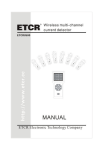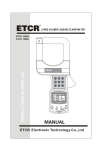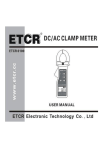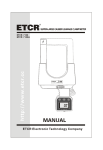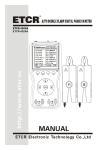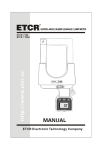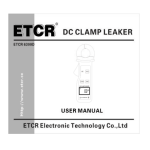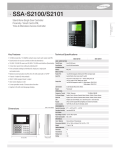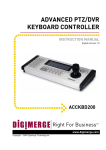Download "user manual"
Transcript
CONTENT Warning................................................................................................. 1 I.Brief Introduction.............................................................................. 3 II.Electrical Symbol ............................................................................ 3 III.Series Model .................................................................................. 4 IV. Technical Specifications .................................................................. 4 V. Instrument Structure ......................................................................... 6 VI. Instrument Operation ...................................................................... 7 1 Turning on and off ...................................................................... 7 2. Selecting Power-saving Mode .................................................. 7 3. Date and Time Setting............................................................... 7 4. Auto Record Internal Setting ..................................................... 8 5. Data Inquiry ............................................................................... 8 6. Deleting Data............................................................................. 9 7. Leakage/current measurement................................................. 9 8. Real-time Monitoring ............................................................... 11 9. Data Download........................................................................ 11 VII. How to operate the monitor software........................................... 12 1. Home Page ............................................................................. 12 2. Real-time Monitoring Menu..................................................... 13 3. Alarm Prompt .......................................................................... 13 4. Storing Waveform.................................................................... 14 5. Historical Inquiry Display......................................................... 14 6. Reading Historical Data .......................................................... 15 7. Historical Data Queuing in Ascending Order .......................... 15 8. Historical Data Queuing in Descending Order........................ 16 9. Historical Data Storage ........................................................... 16 VIII. Replacing Battery........................................................................ 17 Ⅸ. Accessories................................................................................... 18 Warning Thank you for buying Three-Channel Leakage/Current Monitoring Recorder manufactured by our company. Please keep to the following requirements in order to use the product properly: ——Read the User Manual carefully. ——Keep to the safety rules and precaution given in the manual strictly. u Pay special attention to safety when using this instrument in any case. u Observe the text and symbols attached to the front and rear panels of the instrument. u Please replace the battery with a new one when the batter voltage is so low that the LCD display is dim. u This instrument can not be turned off automatically. Please turn off it after use. u Don not use the instrument to measure a line with a voltage higher than 600V. u It is forbidden to use the instrument when neither rear cover of the instrument nor the batter cover is in place. u Never use the instrument when the instrument case or measuring wire is broken and therefore any metallic part is exposed. u Don not place the instrument at a environment with high temperature, high humidity, condensation and direct sunshine for a long time u It is necessary to maintain the instrument and clamp periodically to keep them clean. Don not wipe the clamp by using corrosive medium or abrasive object. u Avoid impact upon the current clamp, especially its mating surface u Please observe the correct polarity when replacing the battery. Remove the battery from the instrument if you expect not to use the instrument for a long time. u Operation, disassembly and repair of the instrument must be carried out only by a authorized and qualified person -1- u When there is an instrument fault, never use it because continual use may result in danger. In this case, isolate the instrument immediately and delivered to an authorized agency for dealing with it. u The user must follow the safety instructions preceded by “ ”warning symbol on the instrument and manual. u The user must follow observe the instructions preceded by “ symbol on the instrument and manual. -2- ”danger I.Brief Introduction ETCR8300 series Three-Channel Current/Leakage Monitoring Recorder is well designed and manufactured for online measurement, monitoring and recording of Three-Channel AC leakage / current at the same time. It is composed of a tester, monitoring software, current clamp and communication cable, etc. This instrument has been widely applied the 380/220 Power system. It can provide a safety and convenience measurement with accurate results. The instrument has a large LCD display with blue background and a large storage space. 3900 sets of data can be stored in the instrument. Three- channel current value can be display on the screen. System clock can be set. In addition, the instrument can automatically store data at an interval, which is adjustable from 1 to 99 min. Monitoring software provides online and real-time monitoring and historical data inquiry. With the software developed by our technical department, the users can read, inquire, store, generate and print a fitting curve and report. The current clamp is made of a special alloy, adopts the latest CT technique and magnetic shielding technique and is not almost interfered by external magnetic field. This ensures high accuracy, high stability and high reliability of the values which are measured continuously. II.Electrical Symbol Extremely dangerous!The operators must keep to the safety rules strictly, otherwise, electric shock will result in death or injury. Dangerous!The operators must keep to the safety rules strictly, otherwise, electric shock will result in will result in death or injury. Warning!The operators must keep to the safety rules strictly, otherwise, personal injury or equipment damage will occur.. Double insulation Alternating current (AC) Direct current (DC) -3- III.Series Model Model ETCR8300 ETCR8300B Range Resolution Accuracy Clamp size 0.0A-500A 0.1A ±2%±5dgt 35mm×40mm 0.00mA-20A 0.01mA ±2%±5dgt 25mm×30mm IV. Technical Specifications Measuring Three- channel AC leakage current and AC Functions current, on-line monitoring and recording, locating insulation faults and repairing electrical lines. Power source Testing Method Display Method DC6V, alkaline battery LR6 1.5V×4 Clamp CT, true RMS LCD:128dots×64dots Instrument Tester(L×W×H): 75mm ×170mm ×30mm Dimension Current clamp(L×W×H): 170mm ×70mm ×38mm Weight LCD Dimension Shield Type Sampling Rate Data storage Time Setting Recording Time Line Voltage Tester: 240g (battery included) Current clamp: 170g Display field: 44mm×27mm Type B: Double shielding 2 samples/s 3900 sets (data loss does not occur after power failure or replacing the battery) Recording internal adjustable from 1 to 99 min, If set to 0 min, the auto-store function is turned off Continuously operate for about 10 days at the power-saving mode Line with a voltage up to AC600V -4- Overflow Display The “OL” symbol is displayed when a measured value is beyond the measurement range A Low-Battery symbol is displayed and the user should Battery. replace the battery with a new one when the battery Voltage voltage drops to 4.6V to 4.8V. In this case, the measured values are still accurate. Rated Power about 5mA at the power-saving mode, maximum current consumption: 20mA Lead Length 2m Temperature Working: -10℃~40℃;below 80%rh and Humidity Storage: -10℃~60℃;below 70%rh Variation Insulation Resistance Safety Codes 1% variation when below -10℃ or higher than 40℃ Higher than 100MΩ, 1000V IEC1010-1, IEC1010-2-032, Pollution Class 2, CAT Ⅲ(600V), IEC61326(EMC standard) -5- V. Instrument Structure 1. Current clamp interface 2. LCD(128dots×64dots, Chinese and English MMI) 3. Up, down, left, right keys and MEM control key 4. Instrument body 5. POWER key (for turning on and turning off the instrument) 6. RS232 interface for data download 7. Round-end current clamp 8. Current clamp signal output plug -6- VI. Instrument Operation 1 Turning on and off Turn on the instrument by pressing the POWER key. The LCD will light up. The display on the LCD is as shown in the left figure. If the LCD display is dim, the battery voltage may be low. If so, replace the battery with a new one. Press the POWER key again to turn off the instrument. This instrument can not be turned off automatically. Please turn off it after use. 2. Selecting Power-saving Mode Press the DOWN arrow key at the measurement status to turn off the LCD back-light and enter the power-saving mode. Press the UP arrow key to turn on the backlight. The power consumption at the power-saving mode is only 20 percent of the one at the common mode (the backlight is turned on). It is recommended that the power-saving mode be adopted for long-time online measurement and recording. 3. Date and Time Setting Press the MEM key at the measurement state to access the function menu, press the UP or DOWN arrow keys to move the cursor to the Time Setting item, and press the MEM key again to enter the date& time setting mode. At the date& time setting mode, press the UP/DOWN arrow keys to change values, press the LEFT or RIGHT keys to move the cursor, press MEM key to “confirm” or “cancel” the setting. After the recording interval has been set, return to the measurement state. The instrument will automatically store the measured values at the set interval. The instrument can store up to 3900 data sets. If the memory is full, FULL will be displayed on the LCD. The instrument can store new data only after some of stored data is deleted. -7- 4. Auto Record Internal Setting Under the test mode, press UP and Down array to set the internal time for automatically record. The internal time can be set from 1 to 99 min. 00 min means auto record function is closed, which is default setting after each boot up. The instrument doesn’t have automatic clock function. The date and time will reset to the default value (08.08 AM, Aug 8, 2008) each time the instrument is turned on. Press the MEM key to “Cancel” or maintain the previous setting. The storage interval is defaulted to “00” min each time the instrument is turned on, that is to say, no measured value is stored. 5. Data Inquiry At the measurement state, press the MEM key to access the function menu, press the UP or DOWN arrow keys to move the cursor to “Data Inquiry” item, and press the MEM key to enter the inquiry submenu. Inside the inquiry submenu, the first left line display the current page number and total pages, the third line displays three sets of recorded values, and the right side displays the page number increment. It is allowed to rapidly navigate to the desired page number. Press the UP or DOWN arrow keys to move the cursor and select the page number increment and then press the MEM key to confirm the selection. Press the LEFT and RIGHT arrow keys under the inquiry submenu to move the cursor. Press the MEM key with the cursor located at certain data set to display the detailed information about this data set, including the set number -8- /stored data sets, current amplitude and recording time, etc. Generally speaking, press the arrow keys to move the cursor and press MEM key to confirm the selection under the inquiry submenu. The relevant display is as shown in the following figure: 6. Deleting Data At the measurement state, press the MEM key to access the function menu, press the UP or DOWN arrow keys to move the cursor to “Deleting Data” item, When press the MEM key again, a data deleting tips will pop up. Press the MEM key with the cursor located at “OK” to delete the stored data. Press the MEM key with the cursor at Cancel to cancel the deletion and return to the main menu. It is impossible to recover the deleted data. Take care to delete any data. The deletion operation will delete all of the stored data. 7. Leakage/current measurement Electric shock, dangerous ! The instrument can be operated only by the trained and authorized person. The operators must keep to the safety rules strictly, otherwise, electric shock will result in personal injury or damage to the equipment. Don not use the instrument to measure the lines with a voltage of higher than 600V and current of higher than 20A, Otherwise, electric shock will result in personal injury or damage to the equipment. 1) Connect the current clamp with the instrument body properly, turn on the instrument and enter the measurement mode. 2) Clamp the measured object with the current clamp (ensure that the clamp end should be fully closed),. Observe the reading. If an OL symbol is -9- displayed on the instrument LCD, the measured current exceeds the upper measurement limit of the instrument. 3) Reference legend: In order to measure the leakage current of an electrical equipment, clamp the phase line and neutral line. (take care to clamp the two lines) In order to measure the leakage current of a ground conductor, clamp the ground conductor. (take care to clamp only one conductor) In order to measure the total current of a main line, clamp this main line. (take care to clamp only one line). For the sake of safety, remove the instrument away from the conductor with high voltage and current after measurement has been completed correctly -10- 8. Real-time Monitoring Turn on the instrument and enter the measurement state. Connect a PC with the instrument via a RS232 communication cable supplied with the instrument. Run the software installed in the PC. If the communication is normal, the users can monitor current in real-time manner via the PC. The software can display leakage current dynamically, display current waveform, maximum value, minimum value and average value. In addition, the users can read, inquire, store, analyze, process, sequence historical data and generate and print a fitting curve and report. Historical data can saved as .TXT file or .DOC file. 9. Data Download Connect the instrument with the PC via the RS232 communication cable (supplied with the instrument) and turn on the instrument. Run software, select the Historical Inquiry and read the data. The more the data is, longer time it takes to read them. If the instrument memory is full, it takes about 2min to read all data. -11- VII. How to operate the monitor software ETCR Leakage/Current Monitoring software needs to be installed in Windows XP/2000 systems. The monitor software provides online and real-time monitoring and historical data inquiry. With the ETCR software, the instrument can display current dynamically, display current waveform, maximum value, minimum value and average value. The users can preset the alarm limit. The instrument will generate an alarm when the measured current exceeds the limit. In addition, the users can read, inquire, store, analyze, process, sequence historical data and generate and print a fitting curve and report. The following paragraphs will describe these functions briefly. 1. Home Page Enter the real-time monitoring menu by clicking “Enter” with a mouse. Visit the company website for inquiry if the users require other services. -12- 2. Real-time Monitoring Menu Special notes: You can zoom the waveform by pressing the left key of mouse and dragging the cursor upward or downward when the cursor is located within the waveform display area. 3. Alarm Prompt A red alarm lamp will blink when the measured current value exceeds the preset alarm limit. The users may cancel the alarm setting value. -13- 4. Storing Waveform A waveform may be stored while the current is monitored in a real-time manner. A waveform is stored in BMP format. 5. Historical Inquiry Display The historical inquiry functions include such functions as reading, storing and clearing historical data, generating a curve, printing data, queuing data in ascending or descending order, data backup and page-up and page-down. -14- 6. Reading Historical Data The more the historical data is, longer time it takes to read them. The software provides a reading progress indication. 7. Historical Data Queuing in Ascending Order Queue the historical leakage current values in ascending order. If one value equals to another value, queue them in chronological order. -15- 8. Historical Data Queuing in Descending Order Queue the historical leakage current values in descending order. If one value equals to another value, queue them in reverse chronological order. 9. Historical Data Storage The historical data is stored in TXT format in page -16- VIII. Replacing Battery Observe the correct battery polarity, Otherwise, the instrument will be damaged. Replace the battery with a new one as soon as possible when the battery voltage is low. Don not use the new battery together with a old battery. 1) When the battery voltage drops to 4.6V to 4.8V, a symbol will be displayed on the instrument, indicating the battery voltage is low. Replace the battery immediately. 2) Press the POWER key to turn off the instrument. After confirming that the instrument has been turned off, open the battery cover and replace with a new battery recommended by the manufacturer. Pay special attention to the correct battery polarity. Replace the battery cover, turn on the instrument and confirm that the instrument can operate properly. (as shown in the following figure) -17- Ⅸ. Accessories Tester 1 PCS Current clamp 3 PCS RS232 communication cable 1 PCS ETCR monitor software (CD-ROM) 1 PCS Instrument bag 1 PCS User manual 1 Copy Warranty card and quality certificate 1 Copy -18- Manufactured by ETCR Electronic Technology Company Address: F-3F, No.4 Pengshang Zhifu Road, Jiahe, Baiyun District, Guangzhou, Guangdong, China Post Code: 510440 Tel: (86-20)62199556 62199553 Fax: (86-20)62199550 E-mail: [email protected] Website: www.etcr.cc
























